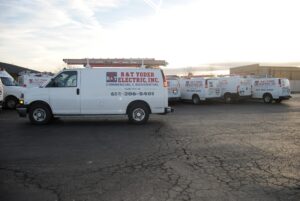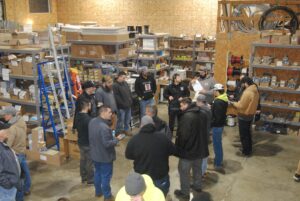Residential Electric Services
Yes, please contact our Residential Service department to get a service contract set up.
We tackle any issues from small residential troubleshooting calls like a GFI receptacle not resetting, or lights and outlets not working to commercial power quality issues and locating/fixing broken underground wires.
When it comes to troubleshooting, it is impossible to provide a cost that is fair to both the homeowner and the electric company before being able to open up any boxes. Although our experience may provide a likely cause of the issue, we find it to be best to communicate with the homeowner during the troubleshooting process to inform them of possible causes and solutions to the problem so an informed decision can be made.
No, we only estimate larger projects and never do ballpark estimates.
There are numerous considerations for when to upgrade a panel. Federal Pacific and Zinsco panels were common from the 1950s to 1980s and should be replaced due to their breakers malfunctioning and creating a fire hazard. If there are signs of water seepage and leaking around or in the panel this will likely lead to a panel replacement. An addition to a large electrical appliance like a hot tub, pool, oven or air conditioner could require a panel upgrade if your existing panel amperage is not high enough for the new appliance.
Yes, we are very adept and pool and hot tub installation. We prefer the hot tub to be there before the electric work is started, but also know that some timelines do not allow for this. We do many pools each year in which we install a subpanel for the pool and complete the bonding of the pool for the pool installers. We then hook up all the pumps and heaters and low voltage lighting transformers Lighting upgrades and changes
We can often do this and get a proposal returned to you quickly if you are able to email a few pictures [email protected]
To be most helpful, please make sure your photos include:
Close up of the electric meter –Entire outdoor meter assembly, from the ground up –Picture with the panel door open –Picture of the panel standing 10-15 feet away from it Pools/Hot tubs
Yes, if doing an estimate, one of our estimators will help you decide on the right amount of light and placement. Our technicians are also well versed in lighting placement and can assist in layout during the project. Remodeling and home additions.
No, we work with homeowners all the time to meet their timeframes and budgets in their particular remodel needs. Even if it is just relocating a couple of can lights and outlets, we can do that. We also do large remodels that include a lot of detailed wire tracing and relocation or even relocating/upgrading the electrical service to accommodate a remodel. Trenching/Excavating
Yes, we are very equipped to trench lines and backfill those trenches. We use a mini excavator for larger projects and trenchers for smaller projects to not disturb as much ground. We have relationships with multiple underground boring companies to complete more complex projects where digging is not an easy option New build
On a new build we can start as soon as all the framing is completed. Typically, we wait until the plumbers and HVAC techs are done to allow them to run their pipe and duct wherever they need to. We then come back in after paint to finish installing all devices, light fixtures and covers Smoke Detectors
Smoke alarm batteries should be replaced annually and the entire unit should be replaced every 10 years Electric car charger
It depends a lot on the specific installation location, but typically we can find a path to the garage that doesn’t require much damage at all to the existing drywall. We can then install conduit or install wire in the attic to place the outlet anywhere you would like. Emergency after-hours work
We do not typically offer after hours service although there are some instances where it may be needed. These types of jobs are generally scheduled in advance.
Commercial Electric Services
Yes, please contact our Commercial Service department to get a service contract set up.
Design-build
Yes, we will work with you at the conception of a project to create budget numbers.
New build
On a new build we can start as soon as all the framing is completed. Typically, we wait until the plumbers and HVAC techs are done to allow them to run their pipe and duct wherever they need to. We then come back in after paint to finish installing all devices, light fixtures and covers
Trenching/Excavating
Yes, we are very equipped to trench lines and backfill those trenches. We use a mini excavator for larger projects and trenchers for smaller projects to not disturb as much ground. We have relationships with multiple underground boring companies to complete more complex projects where digging is not an easy option
Lighting upgrades and changes
Yes, if doing an estimate, one of our estimators will help you decide on the right amount of light and placement. Our technicians are also well versed in lighting placement and can assist in layout during the project.
Yes, we have different sized lifts available to reach nearly all parking lot poles to troubleshoot or replace lights
Yes, we have done numerous large lighting retrofits including car dealerships, parking lots, and showrooms.
Industrial Electrical Services
Yes, please contact our Industrial Service department to get a service contract set up.
Commercial & Residential Solar System Installation
Yes, we have done ground mounted and roof mounted solar arrays of many sizes. We handle everything from designing the system and getting permits to mounting the solar panels and pouring concrete.
Buy Backup Generators
We have installed and service Generac, Kohler and most other standby generators. We couple the generators with a transfer switch in most cases to create a reliable Generator System.
We recommend servicing the generator once a year which includes: Oil and filter change, new air filter, new spark plug and also a transfer test to make sure on loss of power that the entire system will start up with no issues.
We charge $350-$500 for all of the items included above in our service checklist, depending on your specific Generator System.
Electric Vehicles
When contrasted with a gas powered vehicle, an electric vehicle is more affordable on the grounds that gas powered cars require a great deal of support, while an electric vehicle doesn’t require a large part of general maintenance and upkeep.
For instance, gas vehicles might get oil spillages now and again and need fixing. They likewise need new parts frequently, new oil and sifted fuel, and new brake pads for when the old ones come up short, while an electric vehicle doesn’t need this same level of maintenance.
A majority of the parts you’ll find in a gas vehicle are not in the EV, and that implies less expense of upkeep.
The expense of charging an electric vehicle differs by where you live, your overall use of power, and the charge you use.
Typically, it costs around $50 to $100 per charge for your EV (and some charges last weeks, depending on your car and home charging station). Considering the price this gas, this may actually be saving you money! While you’ll see this increase in your power bill, it will save you money in the long run, considering gas is just as expensive per fill up.
Five Reasons Why an Electric Car Charger is the Best Investment For Your Business
If you own an electric car, you know how convenient it is to drive from place to place without worrying about the cost of gas. The only downside is that electric cars typically require several hours of charging time before getting back on the road again. Luckily, there are a few devices that make it easier to charge your electric car. An electric car charger can be a great investment for your business because they can help your customers easily access your services and save them money in the long run. Even though many people think that using an electric car charger at home isn’t worth it, continuing to read will show you five reasons why an electric car charger is the best investment for your business.
Electric car chargers are a great way to show that your business is environmentally friendly. Having them in public areas, such as at your business or during events, spreads awareness about how many people drive electric. Many people don’t know about the options available to them for driving electric, so hosting an electric car charging station is a great way to get the word out and show that your business is environmentally conscious.
People who drive electric cars know that charging their vehicles isn’t as easy as filling up a tank of gas. As a result, they might avoid visiting your business if they aren’t familiar with charging their cars there. By installing an electric car charger at your business, you make it easy for customers who drive electric to charge their cars while they do business with you. This is especially useful during the summer months, when daily charging needs are at their highest.
Many people don’t understand how charging their electric car works, especially when there isn’t a proper charge station nearby. This can lead to frustration, which could hurt customer relationships. Installing an electric car charger could increase customer satisfaction by making it easy for people to charge their cars at your business. If people don’t have to worry about plugging in, unplugging, or dealing with a charge that won’t work, they’ll be less frustrated. This can lead to happier customers who have a better experience overall.
If you want to promote your business, you can do so by installing an electric car charger. Having a charge station at your business could attract people who drive electric and may not have otherwise known about your business. After they see the charger, they might want to stop by your business and try out your services. Even if they don’t use your services, having the charger might entice them to refer their friends and family members to do business with you.
If your business sells environmentally friendly products, an electric car charger is a great way to display your commitment to these items. If you sell items such as solar panels or other sustainable products, installing an electric car charger at your business shows that you’re committed to using sustainable resources. People who drive electric cars often drive other sustainable products, too, so adding a charger shows that you’re committed to the same causes as your customers.
Electric car chargers are a great investment for your business because they’re environmentally friendly, make it easier for customers to access your services, and are a great marketing tool. Having a charger at your business shows commitment to environmental causes and is a great way to bring in new customers.
5 Tips to Consider When Planning Your Electric Home Remodel
It’s no secret that the home remodeling market has exploded over the past few years. With an aging housing stock, affordable housing solutions, and new technologies becoming more commonplace, it’s no surprise that the demand for home remodeling services has shot up. In fact, according to data from Statista , the global home remodeling market is expected to reach a valuation of almost $29 billion by 2021. There are so many factors to consider when undertaking a home remodel. From planning out what you want your new space to look like and which costs you can expect to incur as well as deciding whether you want to do it yourself or hire professionals. A lot of people tend to think electric home removals only involve things like light switches and plug sockets. But in reality, electrical work can become rather complex depending on what types of electrical upgrades you have in mind for your property.
– Know what your electrical upgrade goals are – Conduct an electrical inspection to identify areas of concern – Plan around your budget and timeline – Consider the extra work that comes with certain upgrades – Get a few estimates for your electrical upgrades – Create a home remodeling plan to keep you on track
Assessing the condition of your current electrical system
– Take stock of your electrical system’s features and deficiencies – Document and photograph your system so you have a reference point moving forward – Check and record your system’s current amperage and voltage – Investigate your system to determine whether or not repairs are necessary – Consider hiring a professional to do a complete diagnosis of your system – Find out if a full electrical system replacement is necessary
– Evaluate your needs and wants when it comes to your home’s electrical system – Chart out a rough sketch of what your new system will look like – Make a list of your top priorities when it comes to electrical upgrades – Prioritize your list based on your budget and timeline – Review your list and consider the cost of each upgrade as well as how long each upgrade process will take – Choose the upgrades that best meet your needs and wants – Keep in mind that certain upgrades require more extensive work than others do
– Make a rough estimate of how much your electrical upgrades will cost – Break down your estimates into parts and include potential additions such as permits and licensing fees – Add in a contingency fund for electrical mishaps and unforeseen circumstances – Consider your electrical upgrades as an investment in your home’s future – Investing in your electrical system now is likely to save you money in the long run – Remember that you likely qualify for utility rebates when updating your electrical system – Research and apply for available rebates – Consult with a financial expert to help you structure a financing plan that works for your budget – Consider getting a home equity line of credit (HELOC) if you don’t have enough cash on hand for your electrical upgrades – Take out a low-interest loan if you have excellent credit and have been approved for a long-term mortgage – Remember that it’s important to stay on track with your home remodeling plan
– After doing your research on your home and seeing the value of upgrading your electricity in your home, it’s time to give us a call. Yoder Electric are the electricians you trust. We’ve performed thousands of jobs for satisfied customers. Handling every job with professionalism from your home to your business, you can always count on Yoder Electric to get the job done right.
The electrical system in your home is a critical component that must be maintained and updated periodically. A home remodel is the perfect opportunity to upgrade your electrical system and boost the safety and functionality of your home. Electrical upgrades can vary greatly depending on your needs and wants as well as your budget and timeline. To get the most out of your home remodeling investment, it’s important to know what your upgrade goals are and how much your electrical upgrades will cost.
The Best Ways To Charge Electric Cars At Home
With gas prices rising, more drivers are looking at electric cars as a cheaper alternative. In the U.S., one of the biggest concerns about electric cars is the range. Since they don’t have an unlimited supply of gas in them, how will you charge them? Luckily, there are many different ways to charge your electric car at home. When charging your car at home, you have two options: Level 1 and Level 2 charging. Here is a breakdown of each type of charging and how to do it in your home.
A Level 1 charging station is designed to charge your electric car’s battery at the same rate that it would be drained when you’re driving. This type of charging is also called “trickle charging” because it happens at a slow rate. Since a Level 1 charger typically uses a standard 120-volt outlet, it can take hours to fully charge an electric car. A Level 1 charger is typically installed inside your garage, allowing you to plug it into an outlet there. It’s not designed to be used for daily charging; it’s meant for occasional charging, like when you plan to drive long distance and want to take an electric car. It can take five to 10 hours to fully charge a car that has a drained battery. If your battery is at a low level, a Level 1 charger can take even longer.
A Level 2 charging station is designed to fully charge an electric car in a shorter amount of time. A Level 2 charger runs off 240 volts and is wired directly into your home’s electrical system. It’s the most effective way to charge your car quickly. While a Level 1 charger takes hours to fully charge a car, a Level 2 charger can fully charge a car in two to six hours. You can also use a Level 2 charger in certain public charging stations. While a Level 1 charger is meant for occasional charging, a Level 2 charger is meant for daily charging. This means you’ll have to install it in your garage, but you can use it every day.
There are a few things to keep in mind if you want to charge your electric car at home using a Level 1 charger. First, make sure you have an outlet in your garage that’s about one foot above the ground. This will make it easier for you to plug your car in. You’ll also want to check your home’s breaker box to make sure you have enough circuits to install a Level 1 charger. You’ll need to install a 120-volt outlet near the car. You can call an electrician to do this. This will ensure that your outlet is installed correctly. Before plugging the car in, make sure the outlet isn’t turned off.
If you want to charge your electric car quickly, a Level 2 charger is the best option. To install a Level 2 charger at home, you’ll need an electrician. They’ll install the charger and make sure it’s connected to the right circuits in your breaker box. You’ll also need to have a 240-volt outlet installed near the car. This is where your Level 2 charger will plug into. Before you charge your car, make sure the outlet isn’t turned off. You can use an app to monitor the charging process. Level 2 charging is most beneficial if you have a long commute.
The biggest advantage to charging your electric car at home is that you don’t have to worry about finding a public charging station. This is especially helpful if you have a long commute and are spending a lot of time in your car. Since a Level 2 charger can fully charge a car in a few hours, you can charge your car at home before your commute and not have to worry about being near a charging station. The main disadvantage to charging your car at home is the cost. Level 2 chargers cost several thousand dollars. But, if you’re charging your car daily, it’s worth the cost. Another disadvantage is that you’ll need to find room in your garage for a charging station. This means you may have to rearrange your garage or install new electrical outlets.
Before you start installing charging stations, you’ll want to decide where you’ll put them. The best place to install a charging station is near the car. But where? When charging your car at home, you have a few options. You can install a wall-mounted charging station. Or you can mount the station to the floor or on a table. If you’re installing a charging station on the wall, make sure you choose a wall that has enough space. You’ll also have to make sure the wall is capable of supporting the weight of the charger. You can also install a charging station on the ground. If you decide to install the station on the ground, make sure it’s somewhere that’s easy for you to access.
The best way to charge an electric car at home is with a Level 2 charger. This way, you’ll fully charge your car in a few hours, instead of a few days. Level 2 chargers are expensive. But they’re worth the cost if you’re charging your car daily. It can also be helpful to install a Level 1 charger in case you ever need to charge your car when it has a very low battery.










